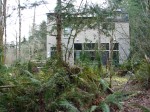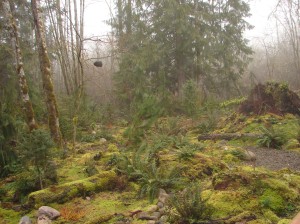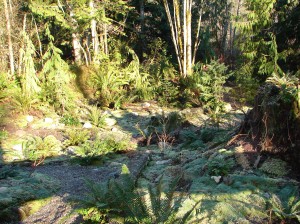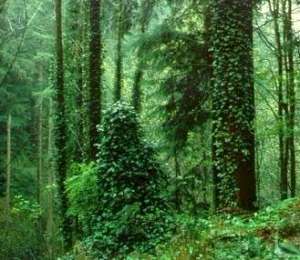A decade or so ago, my wife said to me: you should have a blog. Blogging was becoming popular, and ‘new media,’ and its practitioners, were darlings of “old” media; some bloggers had book deals, even movies. I laughed and dismissed the idea, for I had no interest in photographing my lunch or comparing my home improvement projects to Garret Eckbo or Frank Lloyd Wright in the way folks seemed to think making dinner turned them into iconic TV chefs. I had opinions on many things, but no story to tell.

The property as it appeared before development. There is the wetland, there is the lake across the street. Here be dragons!
But when I began working in the clearing behind my home, I found there was a story there. A unique story of gardening, of property restriction, of humanity working with and against latter-day forest primeval. There were bad guys (the politicologists, the Mitigation Planner, the Mountain Beavers, the weather and the soil); there were good guys (my family, moss, native plants, the forest, regional history, and of course, me); and in the way of all good yarns, there was the arc of a story: beginning, middle, end (buy a house, “mitigate,” and five years later find out how you did). Back in college, where I majored in Creative Writing (yep), we were given the hoary cliche of basic fiction writing: Get Man in Tree, Throw Rocks at Man, Get Man Down From Tree. I’ve been the man in the tree (frequently, quite literally). Less commonly known principles of storycraft have been present also: Wagon Training (from the movie, Stand By Me, wherein one of the characters says, “you know that show, Wagon Train? They never get anywhere. They just keep…Wagon Training”), which is the principle by which pages are filled in between plot advancement and character development. The television program Lost started out strong and turned into nothing but Wagon Training, for instance.

‘No one is watching house. Is good time for Bigfoot to steal brassieres!’ Imaginary Sasquatch=Frank Peterson and Wagon Train
The other is the literary device known as ‘Frank Peterson.’ Frank Peterson is a character in a story who advances the plot but who does not warrant greater character development himself (Frank also goes by Rosencrantz and Guildenstern). Horace Greeley was Frank Peterson–America went West, and stuff happened there, but what do you know about Horace Greeley? The citizens of Munchkinland were Frank Peterson (“Follow the yellow brick road, Dorothy!”), as was the White Whale, and any cowpoke who ever said, ‘They went thataway!’ Frank Peterson is enormously important to every story, but not so much so that the teller of the tale digresses into who Frank Peterson is, or why, or what Frank Peterson cares about. My wife and daughter have occasionally been both Wagon Trains and Frank Peterson; and those people who have helped me, or read these pages, or have commented here are among the finer Frank Petersons around. Thank you so very much, Frank; you know who you are. You are my very good friend, though we have not met.
So while this is a blog, at times seeming to have been about gardening, or landscaping, or moss; or the design and making of things; and other times politics or ecology. There has been science and anthropology and history and occasions when I may have attempted to be witty or wry or even ironic; really, this entire time: it was a Story. The story of my life, living in a new situation, and how it happened, and what I thought and did. This tale has been of the outsized character of me, and I also have served as your sometimes omniscient narrator. Can you trust me? Have you trusted me? I have given facts and Latin names, photographs and places to go where you can check my work, but can I crack a walnut with my bare hand, are my shoulders really the size of cantaloupes? What we know is that I willingly and obliviously climbed the tree; then, the Mitigation plan, the City of Sammamish, and the site threw metaphorical rocks at me; and one day, well before the five-year period in which the story was to occur was up, I realized there were no more ‘rocks’–but before I could climb down from my tree I fell out. I am just as surprised as you are (maybe not about this being a story, but definitely about the story being over): and here is where this story ends.
I will miss my moss and the cool green secret shaded places in the woods where I sat for rare quiet and solitude. I will miss the Pileated woodpeckers, the brown creepers, and the young spotted fawns nursing on wobbly legs; miss the call of the owl and the mystery noises in the darkness, those things undiscovered, or unimagined. I will long remember the chilling notes of midnight coyotes, the spectral lynx in the morning mist, and the dark black night shadow when the bear leaned on the fence as I very nearly leaned on the bear, and both our terror as we crashed away from one another in the darkness. I will miss those things that made living here at once impossible and thrilling. I will miss the beauty of the dappled morning sun, those things sadly unborn of my mind and hand here, and I will even miss those things that made for struggle and toil. And if you are reading this, I will miss you. All of these things have made both me and this.
There may yet be a story for me to tell, but it won’t be here. The thistles are gone, the area is no longer sensitive, and tomorrow it will no longer be mine. My new story might be one of gardening or landscaping or the making of things or improving my home. I don’t know. Or I may decide that keeping these pages is also a task, one that requires commitment and constant freshness, another master to serve when time is short. You will just have to check back, I guess.
When David Douglas was traversing the Pacific Northwest of the 1820s, periodically he would round a bend in the river or come to a wide point in the trail, and be confronted with someone he knew–fewer than 2,000 Europeans in a few million square miles of range, and he’d just bump into them. Think of me that way. We are on our trails now, separately, but I will still be travelling. Perhaps you will find a storm-fallen tree on your property, and I will be the man who shows up with two chainsaws to help you remove it. I am the man you see, the one in the camouflage shorts, with the big steel shovel, gardening in the driving rain and snow.
We will see each other, Alki (By and by).
# # #

























































